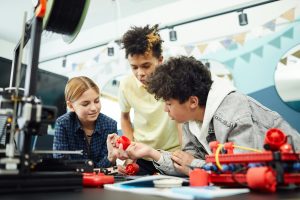Gamification in Education: Engaging Students with Interactive Challenges
Gamification, the incorporation of game-like elements in non-game settings, has been making waves in the field of education. With technology playing a significant role in the lives of today’s students, traditional teaching methods are becoming increasingly less effective in engaging and motivating students. This has led educators to search for innovative ways to make learning more appealing and enjoyable for students. Gamification has emerged as a promising solution, offering interactive challenges that not only incorporate elements of fun but also enhance the learning experience. In this article, we explore the concept of gamification in education and how it can be used to engage students with interactive challenges.
The Rise of Gamification in Education
The use of gamification in the education sector has gained popularity in recent years, as the benefits of this approach become more apparent. With the rise of digital learning tools and platforms, educators are now able to transform the traditional textbook teaching method into a more interactive and engaging experience. This has led to the development of various gamification techniques that leverage game mechanics, such as points, leaderboards, and badges, to create a game-like learning environment.
Benefits of Gamification in Education
The main benefit of gamification in education is its ability to make learning fun and engaging for students. By incorporating game-like elements, students are more motivated to participate and complete learning tasks, which can improve their overall learning outcomes. Studies have also shown that gamification can promote higher levels of retention and engagement, as students are more likely to remember and understand concepts that they learn through interactive challenges.
Furthermore, gamification can also help to develop students’ critical thinking and problem-solving skills. Through interactive challenges, students are encouraged to think creatively and strategize in order to achieve a specific goal. This promotes a deeper understanding of the subject matter and encourages students to apply their knowledge in real-world scenarios.
Gamification in Action: Examples of Interactive Challenges
The possibilities of using gamification in education are endless. Educators can incorporate various game elements into their teaching methods to create interactive challenges that align with their learning objectives. Here are some examples of how gamification can be used in different subjects:
Mathematics
Gamification can make learning math more enjoyable and less intimidating for students. For instance, a math game where students have to solve equations or complete math-related challenges to unlock the next level can make learning math more engaging. Leaderboards can also be used to foster healthy competition among students and motivate them to improve their math skills.
Language Learning
Gamification can also be applied to language learning, where students can earn points or rewards for completing language tasks. For instance, students can be tasked with completing vocabulary quizzes, listening to audio exercises, or engaging in conversations with their peers in the target language. Through these interactive challenges, students can improve their language skills while having fun.
Science
In science classes, gamification can be used to encourage students to understand complex concepts through interactive challenges. For example, students can be tasked with solving puzzles or participating in virtual science experiments to better understand scientific principles. This not only makes learning science more enjoyable but also promotes a hands-on approach to learning, which can lead to a deeper understanding of the subject matter.
Challenges of Implementing Gamification in Education
While gamification in education has numerous benefits, it also comes with its own set of challenges. One major challenge is the design and development of gamified learning activities. It requires a significant amount of time and resources to create interactive challenges that align with the learning objectives. Moreover, educators also need to ensure that the gamification elements do not overshadow the core content, as the ultimate goal is still to educate students.
Another challenge is the need for proper assessment methods for gamified learning activities. Traditional assessment methods, such as exams and quizzes, may not fully evaluate the effectiveness of gamification in promoting learning outcomes. Therefore, educators need to either develop new methods or modify existing ones to suit the gamified learning environment.
In Conclusion
Gamification has opened up new opportunities for educators to make learning more enjoyable and engaging for students. With its ability to incorporate game-like elements in education, students are motivated to participate and learn through interactive challenges. However, proper planning and implementation are crucial to ensuring that gamification is effectively used to complement traditional teaching methods. As technology continues to advance, the potential of gamification in education will only increase, and it is up to educators to harness its power to engage and educate the next generation of learners.









